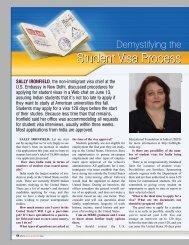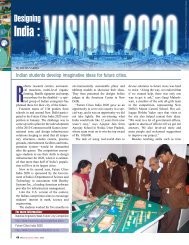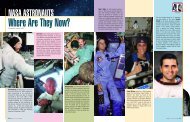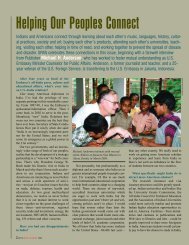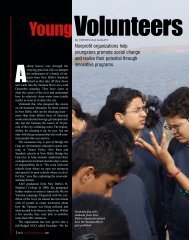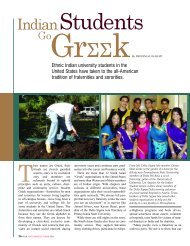A Partnership That is Taking Off, SPAN July/August 2007
A Partnership That is Taking Off, SPAN July/August 2007
A Partnership That is Taking Off, SPAN July/August 2007
Create successful ePaper yourself
Turn your PDF publications into a flip-book with our unique Google optimized e-Paper software.
A <strong>Partnership</strong><br />
<strong>That</strong> <strong>is</strong> <strong>Taking</strong> <strong>Off</strong> HEMANT<br />
By LAURINDA KEYS LONG<br />
A year of U.S.-India aviation cooperation has produced many firsts.<br />
The tremendous growth in Indian<br />
aviation and the importance of th<strong>is</strong><br />
traffic to South Asia and the United<br />
States has prompted the U.S.<br />
Federal Aviation Admin<strong>is</strong>tration to<br />
send its first representative to New Delhi.<br />
A lot has happened since Randall S. Fiertz<br />
arrived in <strong>July</strong> 2006.<br />
“There are several very critical agreements<br />
that have been signed since I’ve<br />
been here that we’ve been negotiating for<br />
a long time, for many years,” says Fiertz,<br />
celebrating h<strong>is</strong> anniversary as senior FAA<br />
representative for South Asia by moving<br />
into a new office on the Embassy compound.<br />
“Whether it’s just the fact that it<br />
was time for those agreements to be<br />
signed or whether it’s the fact that we’re<br />
here on the ground and that gives some<br />
comfort to the Indian government, I don’t<br />
know.”<br />
The U.S. government has shown a<br />
commitment by establ<strong>is</strong>hing th<strong>is</strong> office,<br />
says Fiertz. “U.S. Ambassador David C.<br />
Mulford feels that aviation and our work<br />
together with our Indian counterparts <strong>is</strong><br />
one of the stars in our bilateral relationship.”<br />
Previously, India was covered by<br />
the FAA office in Singapore, but now<br />
Fiertz reports to the Asia-Pacific director<br />
54 <strong>SPAN</strong> JULY/AUGUST <strong>2007</strong><br />
there. India <strong>is</strong> now one of only 15 countries<br />
that has an office of the FAA, which<br />
<strong>is</strong> mandated by the U.S. Congress to provide<br />
aviation safety worldwide.<br />
“Aviation safety means a whole variety<br />
of things,” says Fiertz. “For instance it<br />
could mean ass<strong>is</strong>ting India’s Directorate<br />
General of Civil Aviation, the part of the<br />
Min<strong>is</strong>try of Civil Aviation that’s responsible<br />
for safety oversight. They make sure<br />
that the airplanes and the pilots meet certain<br />
safety standards, and not just commercial,<br />
but general aviation, helicopters,<br />
everybody.<br />
“We work with them,” Fiertz explains,<br />
adding that the key <strong>is</strong> two-way cooperation.<br />
“One thing India and the U.S. share in aviation<br />
that’s relatively unique <strong>is</strong> conductive<br />
weather—lightning and thunderstorms.<br />
Europe doesn’t really have that. It’s a big<br />
aviation <strong>is</strong>sue. The Indians have some<br />
experience in that and we want to share<br />
experience because we can both learn.”<br />
Another safety <strong>is</strong>sue <strong>is</strong> air traffic control,<br />
which <strong>is</strong> directed by the Airports<br />
Authority of India, also an arm of the<br />
Min<strong>is</strong>try of Civil Aviation. A new<br />
Memorandum of Agreement between the<br />
min<strong>is</strong>try and the FAA broadens a decadesold<br />
agreement that limited the range of<br />
aviation topics on which the two agencies<br />
could work together. Now, everything the<br />
FAA does can be done in cooperation with<br />
Indians. “Under th<strong>is</strong> agreement we can<br />
help, for instance, with air traffic control<br />
methodologies, whether it’s equipment or<br />
procedures,” says Fiertz. “It’s not that we<br />
would necessarily give them equipment,<br />
but we might show them technology that<br />
they could be interested in purchasing.”<br />
American manufacturers always had the<br />
right to show the Indian authorities their<br />
products, but without th<strong>is</strong> new Memorandum<br />
of Agreement, the FAA could not<br />
have provided its expert<strong>is</strong>e on which type<br />
of devices or methods would be best in the<br />
local situation.<br />
“We are here to promote aviation safety;<br />
we’re not here to promote any particular<br />
products. We are prohibited from<br />
doing that, actually,” says Fiertz.<br />
Under another new agreement, however,<br />
the FAA <strong>is</strong> able to work with a team of<br />
American companies to present joint<br />
solutions for aviation safety problems.<br />
The result <strong>is</strong> more flexibility and more<br />
possibilities under what <strong>is</strong> called an<br />
Aviation Cooperation Program. A<br />
Memorandum of Understanding for th<strong>is</strong><br />
program was initialed in April during the<br />
BHATNAGAR
v<strong>is</strong>it to India by Federal Aviation<br />
Admin<strong>is</strong>trator Marion Blakey, bringing it<br />
into effect. The formal signing ceremony<br />
took place in Washington, D.C. on June<br />
22 between Indian Min<strong>is</strong>ter of Civil<br />
Aviation Praful Patel and the U.S. Trade<br />
and Development Agency.<br />
Because of U.S. laws meant to block formation<br />
of cartels and monopolies, it <strong>is</strong> difficult<br />
for U.S. competitors in an industry to<br />
work together with a government agency in<br />
the way th<strong>is</strong> program env<strong>is</strong>ions, but the<br />
first Aviation Cooperation Program, set up<br />
three years ago in China, has been very<br />
successful, Fiertz says. “So when the U.S.-<br />
India open-skies agreement was signed by<br />
then-Transportation Secretary Norman<br />
Mineta in 2005, he announced that we were<br />
going to set up th<strong>is</strong> program here in India.<br />
All sorts of U.S. agencies and seed money<br />
have been kicked in for th<strong>is</strong>, through the<br />
U.S. Trade and Development Agency,”<br />
says Fiertz, who <strong>is</strong> the local co-chairman<br />
for the program, along<br />
with Vivek Lall, Boeing’s<br />
senior commercial sales<br />
representative in India.<br />
“What th<strong>is</strong> will allow<br />
us to do <strong>is</strong> offer training.<br />
It provides us with money<br />
that we could offer the<br />
Indians if necessary for<br />
them to travel to the U.S.,<br />
or for Americans to come<br />
to India to share expert<strong>is</strong>e,<br />
for the Indians to see U.S.<br />
technology already implanted<br />
and working and assess what<br />
various corporations might be able to<br />
offer to them.”<br />
Another accompl<strong>is</strong>hment in the past<br />
year was the first U.S.-India Aviation<br />
<strong>Partnership</strong> Summit, in April. “It was an<br />
opportunity for the U.S. government and<br />
U.S. industry and their Indian counterparts<br />
to learn from each other, learn what<br />
was happening here, learn about some of<br />
the experiences in the United States and<br />
elsewhere in the world and an opportunity<br />
to meet each other and make some connections,”<br />
says Fiertz. “By any measure<br />
that I can think of, it was a tremendous<br />
success.” At the opening ceremony there<br />
LAURINDA KEYS LONG<br />
were some 450 people, all the major players<br />
in Indian aviation, and from the United<br />
States, FAA Admin<strong>is</strong>trator Blakey, the<br />
deputy director of the U.S. Trade and<br />
Development Agency, representatives<br />
from the Export-Import Bank, the U.S.<br />
Departments of Commerce, of State and<br />
of Defense.<br />
Fiertz said a principal accompl<strong>is</strong>hment<br />
of the conference, at which half the speakers<br />
were Indian and half were American,<br />
<strong>is</strong> that “very senior people from the FAA<br />
were here and it gave them insight into<br />
Indian aviation. Th<strong>is</strong> will help the FAA<br />
determine where we can best work together<br />
with the Government of India, so when<br />
we go back to Washington and try to figure<br />
out how to allocate our resources,<br />
which are not unlimited, the senior leaders<br />
of the FAA have a sense of what we might<br />
be able to accompl<strong>is</strong>h here.”<br />
And what <strong>is</strong> it that needs to be accompl<strong>is</strong>hed?<br />
“The challenge that<br />
India <strong>is</strong> facing, that<br />
we can work with<br />
them on, <strong>is</strong> how we<br />
can accommodate<br />
th<strong>is</strong> tremendous<br />
growth from an<br />
infrastructure<br />
perspective.”<br />
Randall S. Fiertz, senior Federal Aviation<br />
Admin<strong>is</strong>tration representative for South Asia.<br />
The aviation traffic in India has been<br />
growing by leaps and bounds. Th<strong>is</strong> <strong>is</strong> a<br />
boon to the country and also ra<strong>is</strong>es new<br />
challenges. “Min<strong>is</strong>ter Patel in h<strong>is</strong> speech<br />
at th<strong>is</strong> conference said he expects the<br />
overall passenger growth rate to grow by<br />
25 percent per year in the next 10 years.<br />
<strong>That</strong>’s huge,” says Fiertz. “In the United<br />
States, we’re at a couple of percentage<br />
points and we’re trying to figure out how<br />
to address that. And here there’s been<br />
very limited investment in the infrastructure<br />
that’s needed in the airports and the<br />
air traffic control over the last decade.”<br />
Liberalization of civilian aviation has<br />
allowed th<strong>is</strong> growth. “India has moved<br />
essentially from four airlines to approximately<br />
15 in just the past couple of<br />
years,” notes Fiertz. “And to give you an<br />
example of the number of aircraft—in<br />
2005 Boeing sold more aircraft in India<br />
than in any other country in the world. It’s<br />
astounding. These aircraft are going to be<br />
coming in over the next 10 years, that’s<br />
true, but there are airlines that are receiving<br />
a new plane every month here.”<br />
From 2005 to 2006, India’s air passenger<br />
traffic grew from 22 million to 32 million,<br />
almost a 46 percent increase. “So the challenge<br />
that India <strong>is</strong> facing, that we can work<br />
with them on, <strong>is</strong> how we can accommodate<br />
th<strong>is</strong> tremendous growth from an infrastructure<br />
perspective,” says Fiertz. “To give you<br />
an example, aviation experts have suggested<br />
that in India they can land 30 flights an<br />
hour in an airport with essentially<br />
one runway. In the United<br />
States, we can run double that<br />
in a similar configuration.”<br />
Whether or not the goal <strong>is</strong><br />
60 flights an hour at an Indian<br />
airport, the FAA can “look<br />
into their procedures and their<br />
technology and see if there<br />
are things that we could suggest,<br />
or training for air traffic<br />
controllers or other things we<br />
could do to help them<br />
increase capacity in a safe<br />
way,” says Fiertz. “Safety <strong>is</strong><br />
always the Number One. There <strong>is</strong> natural<br />
concern that when the size of the fleet—<br />
the number of aircraft and number of airlines—increases<br />
as fast as th<strong>is</strong> one does,<br />
<strong>is</strong> the safety oversight capability able to<br />
keep up with th<strong>is</strong> growth. And I don’t for<br />
a second mean to say it’s not. The FAA<br />
has no information to say it’s not safe,<br />
absolutely none. We want to make ourselves<br />
available to let our Indian counterparts<br />
use our expert<strong>is</strong>e if there <strong>is</strong> any way<br />
that they see where they could gain some<br />
benefit from working with us.”<br />
Please share your views on th<strong>is</strong> article. Write<br />
to editorspan@state.gov AVIATION<br />
<strong>SPAN</strong> JULY/AUGUST <strong>2007</strong> 55
Marion C. Blakey, the U.S. Federal Aviation Admin<strong>is</strong>trator, met with Indian<br />
Civil Aviation Min<strong>is</strong>ter Praful Patel and hundreds of other representatives<br />
of the fast-growing Indian aviation industry at the first U.S.-India<br />
Aviation <strong>Partnership</strong> Summit in New Delhi, on April 23, <strong>2007</strong>.<br />
“With that growth comes challenge, and I say that from experience,” Blakey<br />
said. “In the United States, our National Airspace System manages more than<br />
55,000 flights a day. During peak hours, that could mean anywhere from 5,000<br />
to 7,000 aircraft flying around. With traffic levels like that, you can understand<br />
why we’re continually looking for ways to improve our infrastructure. While predictions<br />
call for U.S. passenger traffic to grow a hefty three percent a year<br />
between now and 2020, that <strong>is</strong> dwarfed in compar<strong>is</strong>on to the numbers coming<br />
out of India.…While everyone faces different <strong>is</strong>sues and questions, we’re all<br />
looking for the same answers—a way toward a safer, more efficient system.”<br />
GURINDER OSAN © AP-WWP
Courtesy Airship Management Services<br />
World Sky Race<br />
The World Sky Race, a global race for<br />
lighter than air skyships and Zeppelins,<br />
will trace a route over heritage sites<br />
across the world between <strong>August</strong> 2008 and<br />
March 2009. Developed by the Houston,<br />
Texas-based World Air League, the race will<br />
start at Lakehurst, New Jersey (the home of the<br />
U.S. Navy Lighter-than-Air Center) and, after<br />
completing a global tour, end in New York City.<br />
Proposed Indian sites on the route include<br />
the Qutab Minar and Humayun’s Tomb in New<br />
Delhi, Keoladeo National Park in<br />
Rajasthan, Fatehpur<br />
Sikri and the Taj<br />
Ameriquest<br />
skyship cru<strong>is</strong>ing<br />
above the Golden<br />
Gate Bridge in<br />
San Franc<strong>is</strong>co.<br />
Mahal in Uttar Pradesh.<br />
The skyships will also land next to the Great<br />
Pyramids in Egypt; cru<strong>is</strong>e past the Big Ben in<br />
London; land on the Prime Meridian in<br />
Greenwich; circle the Petronas Towers in Kuala<br />
Lumpur; soar over the Statue of Liberty in New<br />
York and the Col<strong>is</strong>eum in Rome; and line up<br />
above the Golden Gate Bridge in San<br />
Franc<strong>is</strong>co.<br />
Billed as the largest event in h<strong>is</strong>tory to be<br />
witnessed by the greatest number of live spectators,<br />
it <strong>is</strong> also to be the first full global circumnavigation<br />
by a lighterthan-air<br />
skyship. —D.K.




